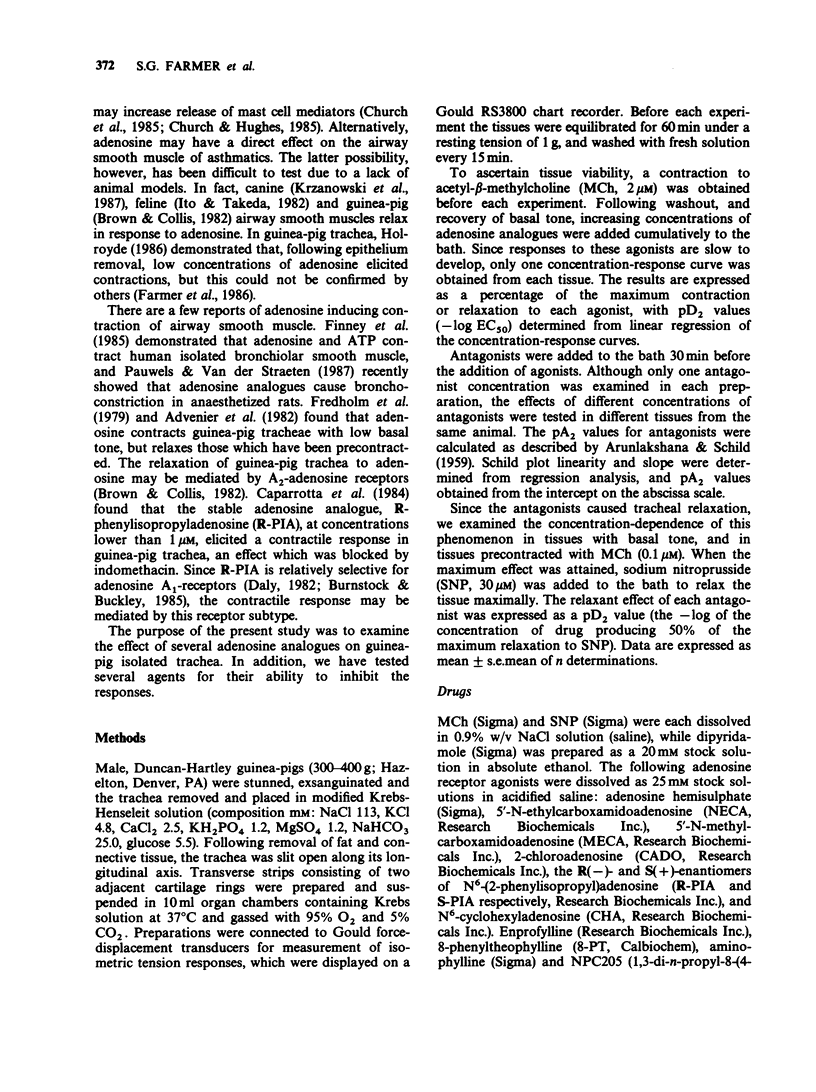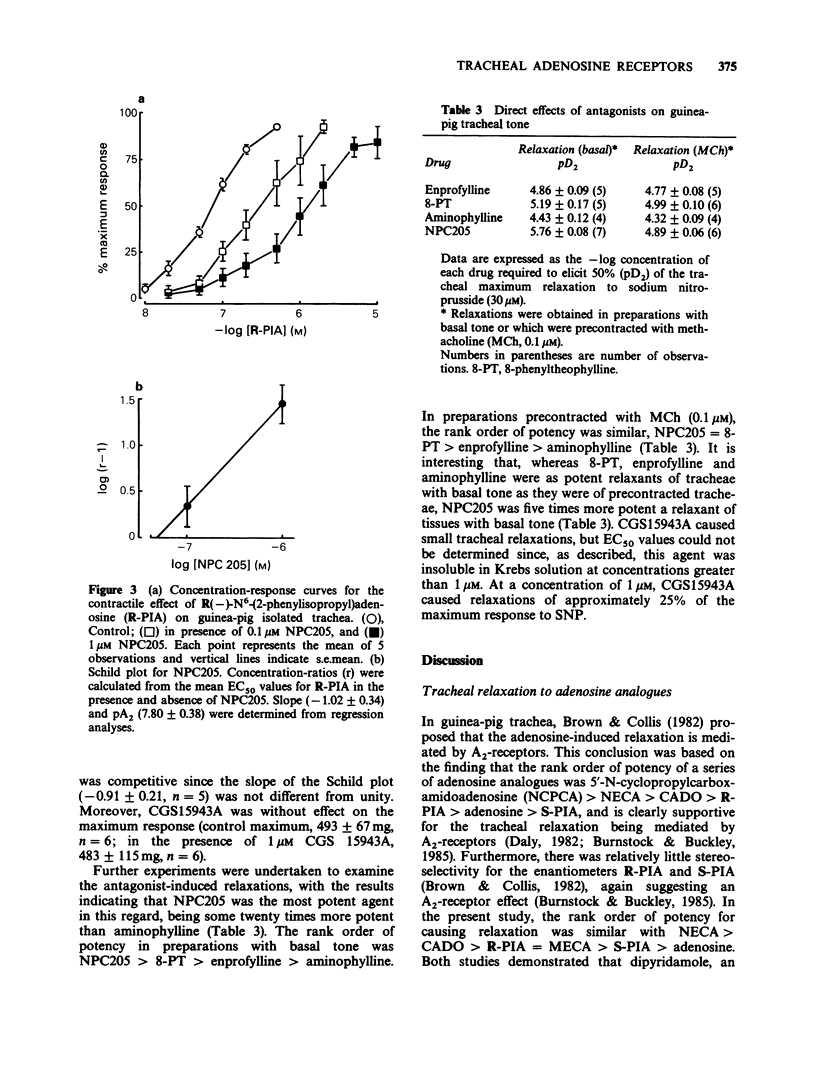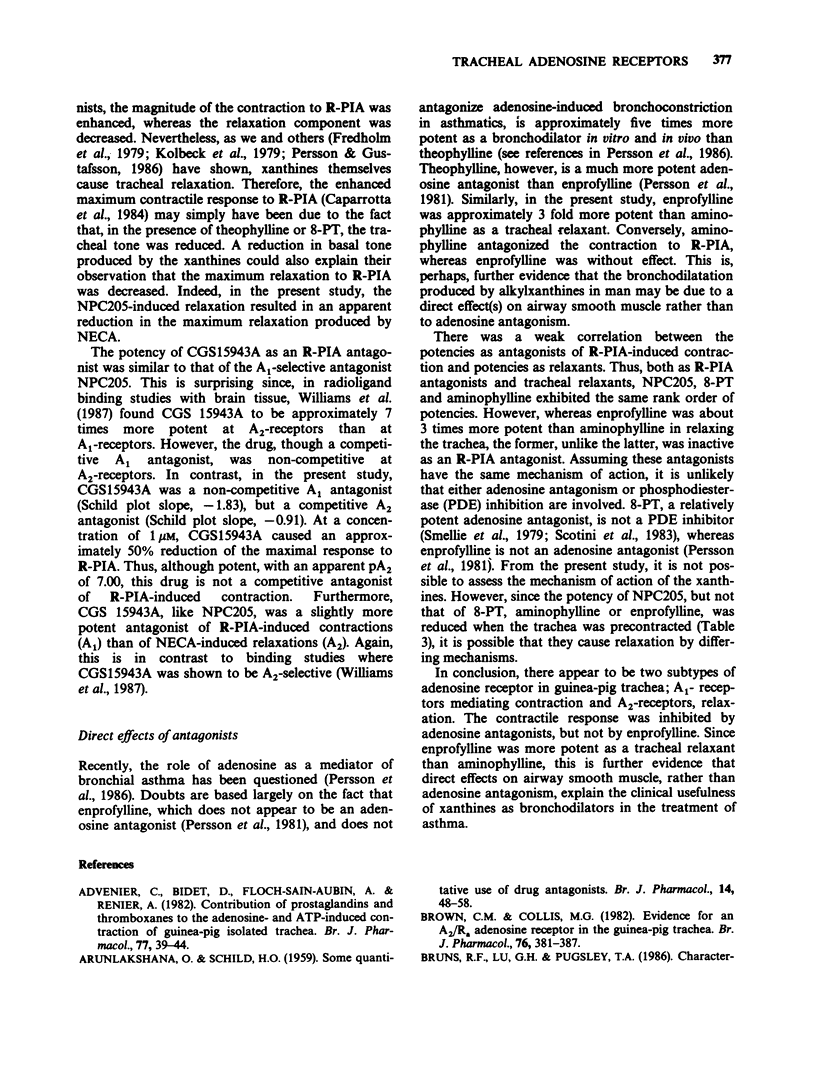Abstract
1. The effects of several adenosine analogues and antagonists on guinea-pig isolated trachea have been examined. 2. 5'-N-ethylcarboxamidoadenosine (NECA), 5'-N-methylcarboxamidoadenosine (MECA) and adenosine (in the presence and absence of dipyridamole) elicited concentration-dependent tracheal relaxation. 3. The R(-)- and S(+)-enantiomers of N6-(2-phenylisopropyl)adenosine (R-PIA and S-PIA respectively), N6-cyclohexyladenosine (CHA) and 2-chloroadenosine (CADO) caused contractions at low concentrations (0.05-2.0 microM), whereas at higher concentrations, relaxation resulted. 4. For tracheal relaxation, the adenosine analogues exhibited the following rank order of potency: NECA greater than CADO greater than R-PIA = MECA greater than S-PIA greater than adenosine. The rank order of potency for inducing contractions was R-PIA greater than CHA greater than CADO greater than S-PIA. These data suggest that relaxation is mediated by adenosine A2-receptors, whereas contraction is the result of activation of A1-receptors. 5. 8-Phenyltheophylline (8-PT), aminophylline, the triazoloquinazoline CGS 15943A and NPC205 (1,3-di-n-propyl-8-(4-hydroxyphenyl)xanthine) each inhibited the R-PIA-induced contractile response, whereas enprofylline was without effect. NPC205, aminophylline and 8-PT were competitive antagonists, but CGS15943A was non-competitive. 6. That the most potent antagonist was the A1-selective agent, NPC205 (pA2 = 7.80), further suggests that the contraction is mediated by A1-receptors. Moreover, NPC205 was 13 times more potent as an antagonist of R-PIA-induced contractions (A1) than of NECA-induced relaxations (A2). 7. The antagonists were also found to relax the trachea by an unknown mechanism. That enprofylline did not antagonize the R-PIA-induced contractions, but was 3-4 times more potent a tracheal relaxant than aminophylline, further suggests that a direct effect on airway smooth muscle, rather than antagonism of endogenous adenosine, is more relevant to the bronchodilator effect of alkylxanthines in the treatment of asthma.
Full text
PDF







Selected References
These references are in PubMed. This may not be the complete list of references from this article.
- ARUNLAKSHANA O., SCHILD H. O. Some quantitative uses of drug antagonists. Br J Pharmacol Chemother. 1959 Mar;14(1):48–58. doi: 10.1111/j.1476-5381.1959.tb00928.x. [DOI] [PMC free article] [PubMed] [Google Scholar]
- Advenier C., Bidet D., Floch-Saint-Aubin A., Renier A. Contribution of prostaglandins and thromboxanes to the adenosine and ATP-induced contraction of guinea-pig isolated trachea. Br J Pharmacol. 1982 Sep;77(1):39–44. doi: 10.1111/j.1476-5381.1982.tb09266.x. [DOI] [PMC free article] [PubMed] [Google Scholar]
- Brown C. M., Collis M. G. Evidence for an A2/Ra adenosine receptor in the guinea-pig trachea. Br J Pharmacol. 1982 Jul;76(3):381–387. doi: 10.1111/j.1476-5381.1982.tb09231.x. [DOI] [PMC free article] [PubMed] [Google Scholar]
- Bruns R. F., Lu G. H., Pugsley T. A. Characterization of the A2 adenosine receptor labeled by [3H]NECA in rat striatal membranes. Mol Pharmacol. 1986 Apr;29(4):331–346. [PubMed] [Google Scholar]
- Caparrotta L., Cillo F., Fassina G., Gaion R. M. Dual effect of (-)-N6-phenylisopropyl adenosine on guinea-pig trachea. Br J Pharmacol. 1984 Sep;83(1):23–29. doi: 10.1111/j.1476-5381.1984.tb10115.x. [DOI] [PMC free article] [PubMed] [Google Scholar]
- Church M. K., Hughes P. J. Adenosine potentiates immunological histamine release from rat mast cells by a novel cyclic AMP-independent cell-surface action. Br J Pharmacol. 1985 May;85(1):3–5. doi: 10.1111/j.1476-5381.1985.tb08823.x. [DOI] [PMC free article] [PubMed] [Google Scholar]
- Coleman R. A., Levy G. P. A non-adrenergic inhibitory nervous pathway in guinea-pig trachea. Br J Pharmacol. 1974 Oct;52(2):167–174. doi: 10.1111/j.1476-5381.1974.tb09697.x. [DOI] [PMC free article] [PubMed] [Google Scholar]
- Cushley M. J., Tattersfield A. E., Holgate S. T. Adenosine-induced bronchoconstriction in asthma. Antagonism by inhaled theophylline. Am Rev Respir Dis. 1984 Mar;129(3):380–384. doi: 10.1164/arrd.1984.129.3.380. [DOI] [PubMed] [Google Scholar]
- Cushley M. J., Tattersfield A. E., Holgate S. T. Inhaled adenosine and guanosine on airway resistance in normal and asthmatic subjects. Br J Clin Pharmacol. 1983 Feb;15(2):161–165. doi: 10.1111/j.1365-2125.1983.tb01481.x. [DOI] [PMC free article] [PubMed] [Google Scholar]
- Daly J. W. Adenosine receptors: targets for future drugs. J Med Chem. 1982 Mar;25(3):197–207. doi: 10.1021/jm00345a001. [DOI] [PubMed] [Google Scholar]
- Farmer J. B., Farrar D. G. Pharmacological studies with adenine, adenosine and some phosphorylated derivatives on guinea-pig tracheal muscle. J Pharm Pharmacol. 1976 Oct;28(10):748–752. doi: 10.1111/j.2042-7158.1976.tb04040.x. [DOI] [PubMed] [Google Scholar]
- Farmer S. G., Fedan J. S., Hay D. W., Raeburn D. The effects of epithelium removal on the sensitivity of guinea-pig isolated trachealis to bronchodilator drugs. Br J Pharmacol. 1986 Oct;89(2):407–414. doi: 10.1111/j.1476-5381.1986.tb10274.x. [DOI] [PMC free article] [PubMed] [Google Scholar]
- Finney M. J., Karlsson J. A., Persson C. G. Effects of bronchoconstrictors and bronchodilators on a novel human small airway preparation. Br J Pharmacol. 1985 May;85(1):29–36. doi: 10.1111/j.1476-5381.1985.tb08827.x. [DOI] [PMC free article] [PubMed] [Google Scholar]
- Fredholm B. B., Brodin K., Strandberg K. On the mechanism of relaxation of tracheal muscle by theophylline and other cyclic nucleotide phosphodiesterase inhibitors. Acta Pharmacol Toxicol (Copenh) 1979 Nov;45(5):336–344. doi: 10.1111/j.1600-0773.1979.tb02402.x. [DOI] [PubMed] [Google Scholar]
- Ghai G., Zimmerman M. B., Hopkins M. F. Evidence for A1 and A2 adenosine receptors in guinea pig trachea. Life Sci. 1987 Sep 7;41(10):1215–1224. doi: 10.1016/0024-3205(87)90199-8. [DOI] [PubMed] [Google Scholar]
- Holroyde M. C. The influence of epithelium on the responsiveness of guinea-pig isolated trachea. Br J Pharmacol. 1986 Mar;87(3):501–507. doi: 10.1111/j.1476-5381.1986.tb10192.x. [DOI] [PMC free article] [PubMed] [Google Scholar]
- Ito Y., Takeda K. Non-adrenergic inhibitory nerves and putative transmitters in the smooth muscle of cat trachea. J Physiol. 1982 Sep;330:497–511. doi: 10.1113/jphysiol.1982.sp014355. [DOI] [PMC free article] [PubMed] [Google Scholar]
- Kamikawa Y., Shimo Y. Mediation of prostaglandin E2 in the biphasic response to ATP of the isolated tracheal muscle of guinea-pigs. J Pharm Pharmacol. 1976 Apr;28(4):294–297. doi: 10.1111/j.2042-7158.1976.tb04156.x. [DOI] [PubMed] [Google Scholar]
- Kolbeck R. C., Speir W. A., Jr, Carrier G. O., Bransome E. D., Jr Apparent irrelevance of cyclic nucleotides to the relaxation of tracheal smooth muscle induced by theophylline. Lung. 1979;156(3):173–183. doi: 10.1007/BF02714008. [DOI] [PubMed] [Google Scholar]
- Krzanowski J. J., Urdaneta-Bohorquez A., Polson J. B., Sakamoto Y., Szentivanyi A. Effects of adenosine and theophylline on canine tracheal smooth muscle tone. Arch Int Pharmacodyn Ther. 1987 Jun;287(2):224–236. [PubMed] [Google Scholar]
- Mann J. S., Holgate S. T., Renwick A. G., Cushley M. J. Airway effects of purine nucleosides and nucleotides and release with bronchial provocation in asthma. J Appl Physiol (1985) 1986 Nov;61(5):1667–1676. doi: 10.1152/jappl.1986.61.5.1667. [DOI] [PubMed] [Google Scholar]
- Pauwels R. A., Van der Straeten M. E. An animal model for adenosine-induced bronchoconstriction. Am Rev Respir Dis. 1987 Aug;136(2):374–378. doi: 10.1164/ajrccm/136.2.374. [DOI] [PubMed] [Google Scholar]
- Persson C. G., Andersson K. E., Kjellin G. Effects of enprofylline and theophylline may show the role of adenosine. Life Sci. 1986 Mar 24;38(12):1057–1072. doi: 10.1016/0024-3205(86)90241-9. [DOI] [PubMed] [Google Scholar]
- Persson C. G., Erjefält I., Karlsson J. A. Adenosine antagonism, a less desirable characteristic of xanthine asthma drugs? Acta Pharmacol Toxicol (Copenh) 1981 Oct;49(4):317–320. doi: 10.1111/j.1600-0773.1981.tb00913.x. [DOI] [PubMed] [Google Scholar]
- Persson C. G., Gustafsson B. Tracheal relaxation from combinations of xanthines and of a beta 2-receptor agonist and xanthines. Lung. 1986;164(1):33–40. doi: 10.1007/BF02713627. [DOI] [PubMed] [Google Scholar]
- Schwabe U., Ukena D., Lohse M. J. Xanthine derivatives as antagonists at A1 and A2 adenosine receptors. Naunyn Schmiedebergs Arch Pharmacol. 1985 Sep;330(3):212–221. doi: 10.1007/BF00572436. [DOI] [PubMed] [Google Scholar]
- Scotini E., Carpenedo F., Fassina G. New derivatives of methyl-xanthines: effect of thiocaffeine thiotheophylline and 8-phenyltheophylline on lipolysis and on phosphodiesterase activities. Pharmacol Res Commun. 1983 Feb;15(2):131–143. doi: 10.1016/s0031-6989(83)80055-1. [DOI] [PubMed] [Google Scholar]
- Smellie F. W., Davis C. W., Daly J. W., Wells J. N. Alkylxanthines: inhibition of adenosine-elicited accumulation of cyclic AMP in brain slices and of brain phosphodiesterase activity. Life Sci. 1979 Jun 25;24(26):2475–2482. doi: 10.1016/0024-3205(79)90458-2. [DOI] [PubMed] [Google Scholar]
- Williams M., Francis J., Ghai G., Braunwalder A., Psychoyos S., Stone G. A., Cash W. D. Biochemical characterization of the triazoloquinazoline, CGS 15943, a novel, non-xanthine adenosine antagonist. J Pharmacol Exp Ther. 1987 May;241(2):415–420. [PubMed] [Google Scholar]


